Aretas IV Philopatris
Aretas IV Philopatris (Arabic: حارثة الرابع Ḥāritat in Nabataean Aramaic)[1] was the King of the Nabataeans from roughly 9 BC to AD 40.
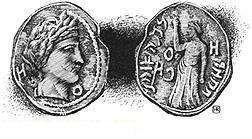
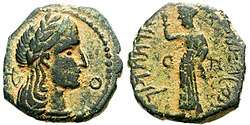
His daughter was married to, and divorced from, Herod Antipas. Herod then married his brother's wife, Herodias. It was opposition to this marriage that led to the beheading of John the Baptist.
After he received news of the divorce, Aretas invaded the territory of Herod Antipas and defeated his army.
Aretas ruled Damascus at the time of the conversion of the Apostle Paul.
Rise to power
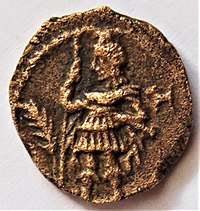
Aretas came to power after the assassination of Obodas III, who was apparently poisoned.[2] Josephus says that he was originally named Aeneas, but took "Aretas" as his throne name.[3] An inscription from Petra suggests that he may have been a member of the royal family, as a descendant of Malichus I.[4]
The capital of his kingdom was a prosperous trading city, Petra, some 170 miles south of Amman. Petra is famous for the many monuments carved into the rose-red sandstone. The power of the Nabateans extended over the caravan routes south and east of Judea, from the seventh century BCE to the second century CE.[5]
His full title, as given in the inscriptions, was "Aretas, King of the Nabataeans, Friend of his People." Being the most powerful neighbour of Judea, he frequently took part in the state affairs of that country and was influential in shaping the destiny of its rulers. While not on particularly good terms with Rome, and though it was only after great hesitation that Augustus recognized him as king, he nevertheless took part in the expedition of Varus against the Jews in the year 4 BC, and placed a considerable army at the disposal of the Roman general.
Aretas had two wives. The first was Huldu to whom he was already married when he became king. Her profile was featured on Nabataean coins until 16 AD. After a gap of a few years the face of his second wife, Shaqilath, began appearing on the coins.[6]
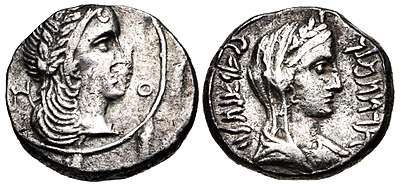
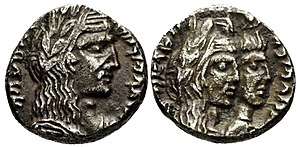
Defeat of Herod Antipas
Aretas' daughter, Phasaelis, married Herod Antipas, otherwise known as Herod the Tetrarch. Phasaelis fled to her father when she discovered her husband intended to divorce her in order to take a new wife, Herodias, mother of Salome. Herodias was already married to his brother, Herod II, who died around 33/34 CE.[7] Antipas married Herodias, and it was opposition to this marriage that led to the beheading of John the Baptist.[8]
Aretas invaded Herod Antipas' domain and defeated his army, partly because soldiers from the army of Philip the Tetrarch (a third brother) changed sides.[9] Antipas was able to escape only with the help of Roman forces.[10]
Herod Antipas then appealed to Emperor Tiberius, who dispatched the governor of Syria, Lucius Vitellius the Elder, to attack Aretas. Vitellius gathered his legions and moved southward, stopping in Jerusalem for the passover of CE 37, when news of the emperor's death arrived. The invasion of Nabataea was never completed.[11]
The Christian Apostle Paul mentions that he had to sneak out of Damascus in a basket through a window in the wall to escape the ethnarch of King Aretas (2 Corinthians 11:32, 33, cf Acts 9:23, 24). However, there is some dispute whether troops belonging to Aretas actually controlled the city, or if Paul was referring to "the official in control of a Nabataean community in Damascus, and not the city as a whole."[12][13][14]
Aretas IV died in CE 40 and was succeeded by his son Malichus II and daughter Shaqilath II.
See also
- List of biblical figures identified in extra-biblical sources
- List of rulers of Nabatea
References
- G. W. Bowersock (1971). "A Report on Arabia Provincia". The Journal of Roman Studies. 61: 221. doi:10.2307/300018.
- Josephus, Jewish Antiquities, 16.296 (16.9.4)
- Josephus, Jewish Antiquities, 16.294 (16.9.4)
- Jane Taylor (2001). Petra and the Lost Kingdom of the Nabataeans. I B Tauris. p. 66. ISBN 9781860645082.
- Ronald Brownrigg (1971). Who's Who In The Old Testament, Volume 2. Wings Books. p. 34. ISBN 0-517-32170-X.
- Jane Taylor (2001). Petra and the Lost Kingdom of the Nabataeans. I B Tauris. p. 69. ISBN 9781860645082.
- Josephus, Antiquities of the Jews, 18.4.6, 18.5.1, and 18.5.4
- Ronald Brownrigg (1971). Who's Who In The Old Testament, Volume 2. Wings Books. p. 34. ISBN 0-517-32170-X.
- Josephus, Jewish Antiquities, 18.109-118
- Ronald Brownrigg (1971). Who's Who In The Old Testament, Volume 2. Wings Books. p. 34. ISBN 0-517-32170-X.
- Jane Taylor (2001). Petra and the Lost Kingdom of the Nabataeans. I B Tauris. p. 72. ISBN 9781860645082.
- Alpass, Peter (2013) The Religious Life of Nabataea BRILL pg 175
- Riesner, Rainer (1998) Paul's Early Period Wm. B. Eerdmans Publishing, 1998 pg 81-82
- Gerd Ludemann (2002) Paul: The Founder of Christianity pg 38
